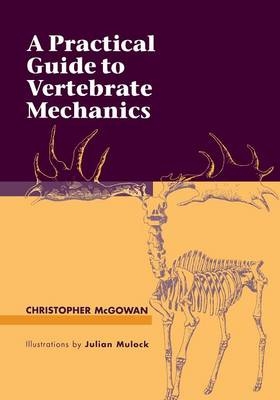
A Practical Guide to Vertebrate Mechanics
Seiten
1999
Cambridge University Press (Verlag)
978-0-521-57673-4 (ISBN)
Cambridge University Press (Verlag)
978-0-521-57673-4 (ISBN)
This book, first published in 1999, takes a hands-on approach to the functional morphology of vertebrates. Practical examples are included in each chapter as well as sample results, so readers unable to conduct the experiments can still benefit from the practicals.
A thorough understanding of the form, function, and design of animals is essential to any working biologist's knowledge. In the author's view, however, this fast-growing field of study can be made much more exciting and accessible with a hands-on, practical approach. This is the view of A Practical Guide to Vertebrate Mechanics. This text, first published in 1999, can be considered an engineering book for biologists. The emphasis is on vertebrates, and each topic begins with a discussion of the underlying principles, followed immediately by practical experiments and laboratory exercises. It begins with a refresher on scaling and measurement, followed by three chapters on the mechanical properties of materials. This leads the discussion to animal materials, which serves to illustrate principles of structure and load, lubrication, physiology, metabolism, and stamina. Finally, the book puts the systems in motion, discussing terrestrial locomotion, flight, and swimming. A Practical Guide to Vertebrate Mechanics will form an important part of undergraduate and beginning graduate courses for zoology, anatomy, biomechanics, and paleontology students.
A thorough understanding of the form, function, and design of animals is essential to any working biologist's knowledge. In the author's view, however, this fast-growing field of study can be made much more exciting and accessible with a hands-on, practical approach. This is the view of A Practical Guide to Vertebrate Mechanics. This text, first published in 1999, can be considered an engineering book for biologists. The emphasis is on vertebrates, and each topic begins with a discussion of the underlying principles, followed immediately by practical experiments and laboratory exercises. It begins with a refresher on scaling and measurement, followed by three chapters on the mechanical properties of materials. This leads the discussion to animal materials, which serves to illustrate principles of structure and load, lubrication, physiology, metabolism, and stamina. Finally, the book puts the systems in motion, discussing terrestrial locomotion, flight, and swimming. A Practical Guide to Vertebrate Mechanics will form an important part of undergraduate and beginning graduate courses for zoology, anatomy, biomechanics, and paleontology students.
Preface; Introduction; 1. A matter of scale; 2. Elasticity; 3. Measuring the strengths of materials; 4. How things break; 5. Bone as a composite material; 6. Structures and loads; 7. Engineering a skeleton; 8. Friction, lubrication and joints; 9. Muscles: the driving force of skeletons; 10. Terrestrial locomotion; 11. Fluid flow; 12. Flight and flying; 13. Swimming and swimmers; Appendix: chapter notes and responses to questions; References; Index.
| Erscheint lt. Verlag | 28.2.1999 |
|---|---|
| Zusatzinfo | 8 Halftones, unspecified; 162 Line drawings, unspecified |
| Verlagsort | Cambridge |
| Sprache | englisch |
| Maße | 183 x 255 mm |
| Gewicht | 665 g |
| Themenwelt | Studium ► 1. Studienabschnitt (Vorklinik) ► Physiologie |
| Naturwissenschaften ► Biologie ► Zoologie | |
| ISBN-10 | 0-521-57673-3 / 0521576733 |
| ISBN-13 | 978-0-521-57673-4 / 9780521576734 |
| Zustand | Neuware |
| Haben Sie eine Frage zum Produkt? |
Mehr entdecken
aus dem Bereich
aus dem Bereich


